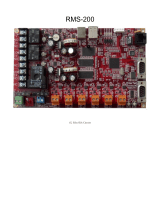
5
Table of Contents
Overview.................................................................................................................................................................................. 7
About This Manual............................................................................................................................................................... 7
Related Documents........................................................................................................................................................... 8
Revisions and Updates.......................................................................................................................................................... 8
Manual.............................................................................................................................................................................. 8
Firmware........................................................................................................................................................................... 8
Safety Considerations...........................................................................................................................................................9
Electrostatic Discharge.........................................................................................................................................................9
Service Tools and Equipment...............................................................................................................................................9
Verification and Performance Tests.................................................................................................................................... 11
Operation Verification Tests............................................................................................................................................... 11
Performance Tests .............................................................................................................................................................. 11
Measurement Techniques............................................................................................................................................... 12
Setup for Most Tests................................................................................................................................................... 12
Current-Monitoring Resistor....................................................................................................................................... 12
Programming.................................................................................................................................................................. 12
Constant Voltage (CV) Tests.......................................................................................................................................... 13
CV Setup.....................................................................................................................................................................13
Voltage Programming/Readback Accuracy................................................................................................................ 13
CV Load Effect........................................................................................................................................................... 13
CV Source Effect........................................................................................................................................................ 14
CV Noise (PARD)...................................................................................................................................................... 14
Transient Recovery Time............................................................................................................................................ 14
Constant Current (CC) Tests........................................................................................................................................... 15
CC Setup..................................................................................................................................................................... 15
Current Programming/Readback Accuracy.................................................................................................................15
CC Load and Line Regulation .................................................................................................................................... 15
CC Load Effect........................................................................................................................................................... 16
CC Source Effect........................................................................................................................................................ 16
CC Noise (PARD) ...................................................................................................................................................... 17
Troubleshooting.................................................................................................................................................................... 25
Troubleshooting Sequence.................................................................................................................................................. 25
Accessing the Flowcharts.................................................................................................................................................... 25
If You Experienced a Selftest Failure or RunTime Error Message.................................................................................26
If You Experienced Other Problems With the Module................................................................................................... 26
Test Points.......................................................................................................................................................................... 48
Built-In Test Functions....................................................................................................................................................... 48
EEPROM Troubleshooting and Initialization.....................................................................................................................51
Troubleshooting.............................................................................................................................................................. 51
Initialization....................................................................................................................................................................51
Disassembly Procedures..................................................................................................................................................... 56
Removing the Module and Module Connector............................................................................................................... 56
Removing the Cover....................................................................................................................................................... 56
Removing the Fan........................................................................................................................................................... 56
Removing the Front Panel Assembly.............................................................................................................................. 57
Removing the Power Board............................................................................................................................................ 57
Removing the Bias Board............................................................................................................................................... 57
Removing the Front Panel Board.................................................................................................................................... 57






















